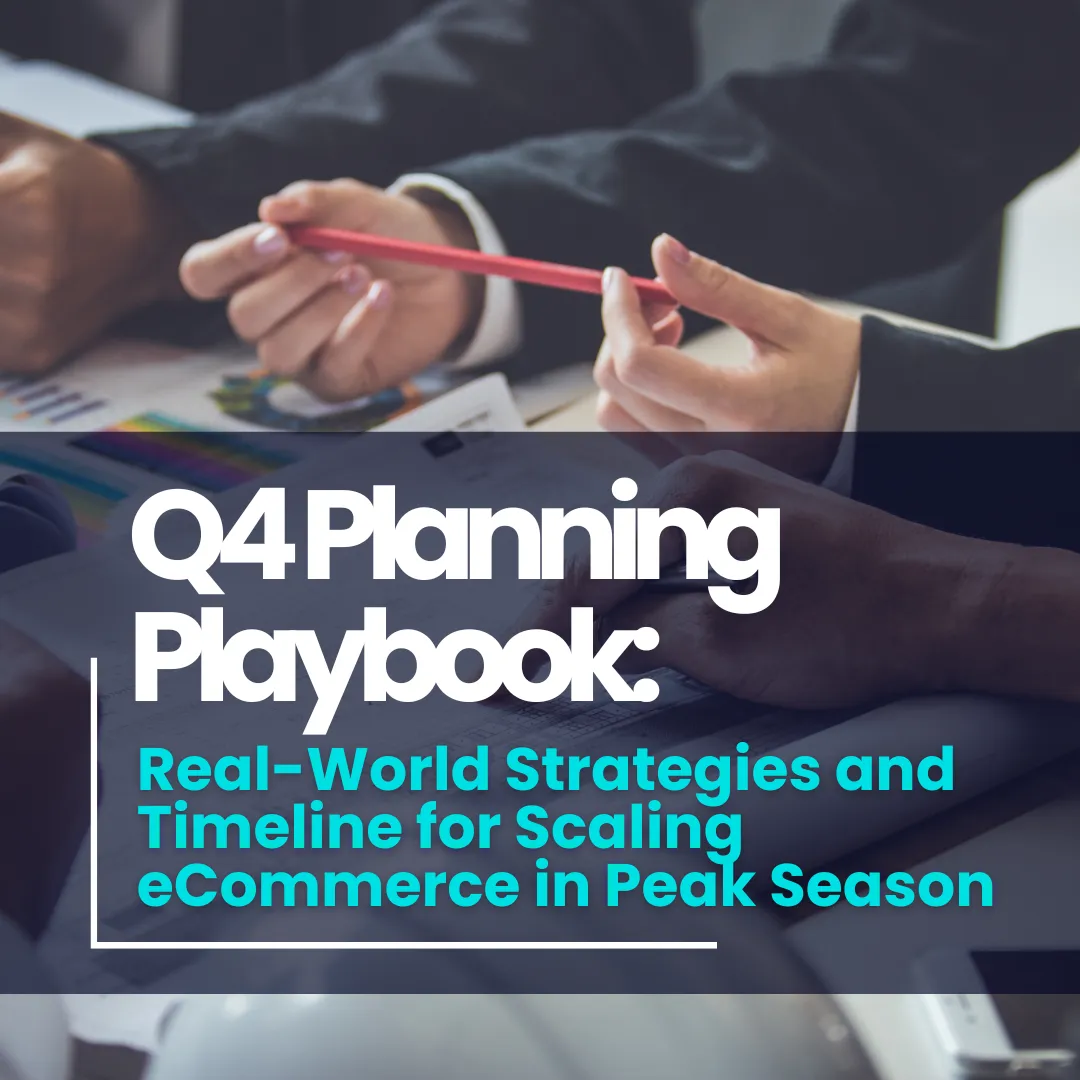
Q4 Planning Playbook: Real-World Strategies and Timeline for Scaling eCommerce in Peak Season
Q4 Planning Playbook: Real-World Strategies and Timeline for Scaling eCommerce in Peak Season
The stakes are higher in Q4
For many Amazon and eCommerce sellers, Q4 isn't just another sales quarter, it's the most important one of the year. It’s the stretch where demand spikes, ad costs rise, and your ability to manage stock and cash flow gets truly tested. In fact, many 7-figure sellers attribute 40% or more of their annual revenue to this three-month window alone.
But here's the truth: success in Q4 is never an accident. It's the result of tight planning, smart capital deployment, and a clear strategy to turn seasonal traffic into profit. Whether you're gearing up for your first big Q4 or refining your process as a returning pro, this playbook is built to give you clarity, structure, and tactical guidance.
Timeline: Reverse Engineering Q4 from the Buy Box
If you’re aiming to be live and ranking by the time Black Friday hits, your prep starts months in advance. Here’s a high-level working timeline:
If you’re placing your Q4 order in October, you’re already late. Supply chains get crowded and cash flow dries up fast. Planning in reverse gives you margin for delays, sellouts, and strategic pivots.
Order planning, why most sellers get inventory wrong
Every year, two things tank seller profits: running out of stock too early or over-ordering and getting stuck with inventory in January.
How to Avoid It:
Use layered forecasting: Combine last year’s numbers with current sales velocity AND consider any listing changes (new images, reviews, A+ content, ad strategy).
Break orders into phases: Instead of placing one massive PO, split it: 70% by early September, 30% buffer top-up in mid-October.
Diversify fulfillment: Have FBM listings ready in case FBA restock limits hit or shipments are delayed.
CapEc Insight: Sellers who used funding to stagger their inventory deliveries saw higher ROI. Why? They avoided warehousing fees and had capital ready to replenish bestsellers quickly
Launch prep: what you need LIVE (and locked) by October
Your listings, advertising strategy, and customer experience all need to be fine-tuned before peak season arrives. These aren’t just boxes to tick - they’re critical levers that determine how well your brand performs during the most competitive quarter of the year.
Let’s break it down.
Optimize Listings with a seasonal Lens
Q4 shoppers behave differently. They’re not just looking for products, they’re searching for gifts, deals, and solutions to their holiday problems. That means your listings need to speak the language of seasonal intent.
Start by reviewing your product titles. Are they optimized for high-intent, seasonal keywords like “holiday bundle,” “Christmas gift for teens,” or “Black Friday deal”? You want to front-load your titles with these phrases to boost visibility and click-through rates during Q4 searches.
Visuals are just as important. Swap out standard product-only shots for lifestyle images that showcase the product in context. A tech accessory on a desk is fine, but a lifestyle shot showing it as part of a student’s remote learning setup? That makes it relevant. You’re not just selling the product; you’re showing how it fits into the customer’s life.
Also consider updating your product listing’s FAQs. Anticipate common seasonal concerns - returns, delivery times, warranty coverage - and address them directly in the Q&A section. This builds trust, especially with first-time buyers shopping under tight holiday deadlines.
Promotions & deals: Plan, Stack, and Secure Early
The promotional calendar in Q4 is non-negotiable. By the time Black Friday rolls around, your deals should already be live or queued up - Amazon’s algorithm rewards early and consistent velocity.
Aim to submit your Lightning Deals by mid-to-late September to secure high-traffic slots. If you’re too late, you may be pushed into low-visibility windows - or miss out entirely.
Beyond Lightning Deals, think about layered promotions. Stackable coupons, “buy more save more” offers, and tiered discounts can drive bigger basket sizes and outperform standard percentage-off promos.
If you’re an FBA seller, use Amazon’s Virtual Bundles tool to group high-margin products. It’s a fast way to increase AOV without additional logistics work, especially if you’re short on time or struggling with fulfillment complexity.
PPC: Spend smarter, not just more
Ad costs spike in Q4 - but so do conversions. The key isn’t just spending more, but spending intelligently.
By late October, increase your daily budgets by 2–3x to remain competitive as traffic surges. But don’t just rely on brute force. Dial in your keyword strategy - tighten targeting around gifting intent (e.g., “gifts for men under $50”) and category bestsellers. Set up both manual and automatic campaigns to cover branded, competitor, and long-tail keywords.
Consider dayparting: Amazon doesn’t offer it natively, but you can simulate it by manually pausing and adjusting bids based on historical performance windows. For example, if your audience shops mostly after 6pm, raise bids during those peak hours and conserve budget earlier in the day.
Most importantly, start your remarketing campaigns now. If you’re running Amazon DSP or off-Amazon traffic, retarget product viewers, cart abandoners, and email leads before ad inventory becomes expensive closer to Cyber Week.
Retention & customer experience: start before the Cart
Great Q4 brands don’t just convert, they retain. Email marketing and customer experience play a massive role here.
Kick off Q4 with a “Wishlist Reminder” campaign to warm up your existing email list. Showcase bestsellers, new holiday bundles, or exclusive subscriber deals. You’re not just pushing products, you’re building anticipation.
On the support side, be proactive. Create or update a clearly visible Returns & Holiday Shipping FAQ. This reduces support tickets, avoids negative reviews, and builds buyer confidence (especially among those shopping for others).
Lastly, adjust your review request timing. Holiday shipping can delay deliveries, and premature review requests can result in negative feedback. Use tools that allow for timing adjustments so that requests hit after confirmed delivery, and when the product is in active use.
Managing Q4 Cash Flow without the whiplash: a smarter way to Fund Growth
Every experienced seller knows that Q4 isn’t just a test of marketing, it’s a stress test on your cash flow.
You’re increasing order volume, ramping up ad spend, front-loading logistics costs, offering deeper discounts, and, crucially waiting longer for returns and Amazon disbursements. In short, it’s the perfect storm of high output and delayed input. Even profitable sellers feel the pinch.
But there’s a smarter way to stay capital-ready for the season, without taking on risky debt, diluting your brand, or pulling cash from other parts of your business.
That’s where CapEc comes in.
Why Traditional Funding Models Fail Sellers in Q4
Most conventional lending options - bank loans, credit cards, and even some inventory financing platforms - just don’t match the pace or needs of eCommerce sellers during peak season. They require lengthy applications, impose fixed repayment schedules, and often base approvals on credit history rather than actual business performance.
That creates a major gap - especially for Amazon sellers who move fast and rely on flexibility.
How CapEc Helps You Stay Funded, Flexible, and Focused
CapEc isn’t just a lender. It’s a capital partner designed around the reality of how Amazon and eCommerce businesses work.
Here’s how:
Advance PO and Invoice Funding
Need to place a big inventory order but your cash is tied up in ads or held in Amazon reserves? CapEc funds up to 75% of your purchase order or invoice value, paid directly to your supplier - so you never miss a restock window or bulk discount opportunity.No Credit Score Checks
Traditional financing penalizes you for not being a decades-old business. CapEc doesn’t. Approval is based on your real store performance, not your credit file. That’s a huge advantage for growing brands, newer sellers, or international sellers scaling up.Pay-As-You-Sell Repayment Model
Instead of rigid repayment dates, CapEc aligns payback with your actual revenue. So you repay gradually, only as your products sell. This approach protects your Q4 cash flow and gives you breathing room when sales volume fluctuates week to week.Amazon Seller Central Integration
Say goodbye to spreadsheets and outdated documents. CapEc integrates directly with your Seller Central account, pulling in live data like revenue, inventory, and ad spend - so you get a quick, seamless funding experience without jumping through hoops.
Seller Snapshot: Turning Opportunity into Revenue with Smart Capital
One CapEc client, an Amazon seller in the wellness category, was preparing to launch two new SKUs in mid-Q4. They’d identified strong keyword opportunities, had packaging locked in, and suppliers ready to go. But ad budgets and restock costs were already eating into their reserves.
By using CapEc’s PO funding, they were able to:
Launch the SKUs three weeks earlie
Secure FBM inventory as a backup in case FBA limits were hit
Run sponsored ads across both new and existing products with confidence
The result? Those two SKUs generated 38% of their total Q4 profit. Without access to flexible capital, those launches would have been delayed - or worse, missed altogether.
Q4 Is Your Growth Engine, Not Just a Spike
Q4 should be the most profitable time of the year and your launchpad for 2026. Sellers who plan early, fund smartly, and execute consistently not only outperform during the holidays, but start January in a stronger position.
✅ Run your numbers early
✅ Forecast conservatively, fund flexibly
✅ Build agility into your supply chain and promotions
✉️ Ready to Scale This Q4?
➡️ Apply for PO or invoice funding now
➡️ Book a free 15-min discovery call
➡️ Join our affiliate program and earn by helping others grow
